June 6th, 2017 From the minute I read about Remote Year, I knew I needed to do it. In typical me fashion, I pretended to debate for a while, batted around pros and cons with my friends and family. I am secretly a very decisive person about huge life changes, but I like to disguise that by venting my fears at every given opportunity, almost like a superstition, an anti-jinx. As long as I name the fear, I might be able to avoid it coming to pass. And since I am blessed with a creative (and overly active) mind, I could imagine a lot of fears. A million ways this trip could go wrong.
But I never voiced the real one.
I told my coworkers I was worried about going freelance, possibly running out of money halfway through this trip. (I wasn’t.) I told my family I worried that I wouldn’t get along with anyone in my randomly-assigned travel group. (I was actually pretty sure that out of 80 people, I’d at least like a couple.) I told my friends that I worried I’d hate some of the cities or countries we visited. (But really, most were on my to-see list anyway.)
I made up all these fears to try and exorcise the one that was really eating at me.
I was afraid this trip would go right.
Fortunately (unfortunately?), it has.
We’re approaching the 6-month mark of this trip. That has made me look deep in the mirror and face what comes next. Because I already know in my bones that this will not be enough for me. One year is not enough.
People talk about getting the travel bug out of your system. People talk about “the trip of a lifetime” and “the last hurrah,” like a honeymoon or a babymoon, those trips people take before they settle into “real life” (as if any other iteration of life is not real, as if anything but the house and the spouse and the 2.5 kids is pure fantasy).
That’s not what this trip is for me. I knew that going into it, and it scared (it still scares) the shit out of me.
This is the start. This is tearing up my roots and growing the wings that have been itching to sprout since I was a kid. This is what I have always wanted to do, where I have always wanted to be. I cannot imagine ever being ready to give this up.
Sure, I can picture a future where I want to stay in one spot for longer than a month at a time. I can envision a few months here, even a year or two there. But I cannot see myself settling down in the traditional sense. I cannot imagine one house in one location ever being enough. I understand how it could be for some people, I understand why that’s what most people want.
But that just isn’t me.
Part of me has known that all along, but it took this trip being what it is to really force me to see it. I would never be happy with normal. I cannot settle for it anymore.
Which leaves me with a lot of questions to work out. What does an unsettled life mean? What the hell does a future without an anchor look like?
It’s not a life most people would sign up for. It’s not a life you can share with someone, except maybe for brief periods at a time. It looks lonely as hell, to be frank.
Is that okay? Is that doable?
I’ve always made my home more in experiences and people than in places or possessions. But if I’m chasing new experiences, how do I make a home with people? Am I doomed to a constantly rotating stream of surface acquaintances, a lifetime of goodbyes?
I’ve always considered myself lucky because I grew up with friends scattered around the globe (the magic of the internet). But any blessing turned on its head can become a curse. My heart has never really been whole because there are pieces of it scattered around the planet, and they’ll never all be in one place at one time. Some days that’s fine and some days it hurts like hell, when someone I care about is in pain and I can’t be there because they’re literally a thousand miles away.
I’m only setting myself up for more of that now.
Remote Year looked perfect because it was a stepping-stone. A way to dip my toe into the deeper waters of solo travel without getting immediately drenched in loneliness on the way down. It has been all of that and more.
But eventually it’s going to end. My new friends are going to go home, or move on to new lives, or keep traveling to other places, but probably not the same ones as me, and definitely never again as a group this big, an actual community that feels like a mobile home, the perfect balance between change and constant, the chance to chase new experiences with the same people, people you can actually get to know on a deeper level, people who have become friends faster than I imagined possible. And once we all go our separate ways, I’m going to have to figure out how to keep moving without them—how to swim in the deep end without a life vest.
I’m going to have to figure out what a future on the drift looks like. How to strike a balance between wings and roots, between constant flights and enough of a layover to keep me grounded.
I have to learn to be lonely.
In a way, I knew that’s what I was signing up for when I dove headfirst into this trip. I jumped anyway. This is just me naming the fear—and perhaps still superstitiously hoping that will allay it somehow.
May 1st, 2017 There are a lot of articles out there about what and how to pack for the insanity that is Remote Year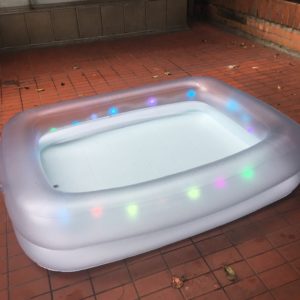 . Some have good tips—advice on how to keep your luggage weight low and yet still bring enough clothes that you won’t be wearing the same 4 outfits on rotation for an entire year. . Some have good tips—advice on how to keep your luggage weight low and yet still bring enough clothes that you won’t be wearing the same 4 outfits on rotation for an entire year.
But to be honest, none of these lists quite cover it all. Key items are left off the lists, items that no self-respecting world-traveler should leave home without. So, for anyone else who might be embarking on their own Remote Year (either with this program or one of the many competitors now springing up), or just for anyone who’s planning to travel for an extended period of time, I offer up these tips. The advice I wish someone had given me when I sat down to plan for this year:
The Ultimate Remote Year Packing List
Part I: Most Often Forgotten Items
(There’s a lot to decide in the lead-up to Remote Year, and in the hustle and bustle, some key items to pack can be lost or forgotten. I’m here to ensure you don’t make the same mistakes I did.)
- Inflatable Pool. I cannot emphasize enough how big a game changer adding a kiddie pool (AKA “paddling pool” for any Brits out there) to my suitcase has been. Month after month, my fellow travelers have been disappointed by apartments without rooftop or garden pools available. But no matter where I wind up living, whether the apartment has no external windows, a cramped kitchen, or just a set of plastic deck chairs in place of a living room, I know I will always have this one key amenity at my disposal: a pool.
When buying your pool, however, make sure to get one with LED lights embedded. This not only makes for cooler Instagram videos, but it also enables you to find the pool and avoid tripping over it in the middle of the night as you stumble through your narrow clown-hallway apartment.
Pro-Tip—Your inflatable pool can also be used as a ball pit, a Jello wrestling stage, or to hold a foam party.
 Neon Wig. I did not anticipate the number of costume, fancy dress and themed events I would be attending this year. Luckily, rather than packing the entirety of your dress-up trunk, you can turn pretty much any normal outfit into a festival-ready one by adding one accessory: a crazily-colored wig. Doesn’t really matter what color (although personally I recommend purple—it goes with everything!), only that it must be outrageously neon enough that it can be used as a flag in the event of an emergency where you get separated from your group of friends at a 30,000 person concert. Neon Wig. I did not anticipate the number of costume, fancy dress and themed events I would be attending this year. Luckily, rather than packing the entirety of your dress-up trunk, you can turn pretty much any normal outfit into a festival-ready one by adding one accessory: a crazily-colored wig. Doesn’t really matter what color (although personally I recommend purple—it goes with everything!), only that it must be outrageously neon enough that it can be used as a flag in the event of an emergency where you get separated from your group of friends at a 30,000 person concert.
The best place I’ve found to buy such wigs is Chapultepec Park in Mexico City, where you can score one for the bargain basement price of $2 USD.
Pro-Tip—Do not put your wig in the washing machine.- Cape. Much like the wig, this will come in handy in an untold number of situations. Just to give you a few examples, it enhances your life when: jumping off a bridge, doing backflips on a pyramid, attending a concert, taking a plane ride where you forget to pack a shirt, napping on an average Tuesday, and in case you need to intimidate anyone in a dark alley.

- Festival/Body Paint. I know, I know, this is an obvious one. When would you not have approximately 1,000 uses to put this to? But you would be surprised by a) the number of people who forgot to pack this everyday essential, and b) how difficult it was to locate in Colombia. Luckily, Colombian regulations are pretty lax, so in a pinch, supposedly “kid-safe edible” regular paint will work in lieu of body/face paint.
- Corkscrew. Especially if you are traveling anywhere in South America, because these cannot be found anywhere for love or money. Occasionally you might luck out and borrow one from a neighbor with a heart of gold, or you may stumble on one in scavenger hunt (try checking the vases and light fixtures of your Airbnb as potential hiding spots). If you do, do not let it out of your sight at any time. The moment you do, it will be spirited away by another thirsty wino who is sick of opening wine bottles via the shoe method (spoiler alert: the shoe method does not work).
And before you ask, no, screw-top wine bottles are not a thing. And no, wine stores do not sell wine openers. Don’t ask, they will look at you like a crazy person and suggest maybe you check a hardware store.
(Hardware stores do not carry them either).
- Witch’s Cauldron. Look, the only way to make enough ajiaco soup to feed a small army is by using a cas
 t iron pot the size of one. And trust me, if you pass through Colombia at any point, you’re going to want to make ajiaco soup. Or really any kind of soup. Soup is the best food anyway, and you’ll be making a lot of new friends on your travels. What better way to endear them to you than by feeding them a mountain of stew? t iron pot the size of one. And trust me, if you pass through Colombia at any point, you’re going to want to make ajiaco soup. Or really any kind of soup. Soup is the best food anyway, and you’ll be making a lot of new friends on your travels. What better way to endear them to you than by feeding them a mountain of stew?
It’s also worth noting that your witch’s cauldron can be used in any spells you may need to cast on your travels. For example, if you break a mirror and doom yourself to several years of breaking everything else around you, and you need to perform a cleansing spell under a full moon with a human heart.
Pro-Tip—Only put your cauldron on the bottom shelf of the fridge. Glass shelves are not strong enough to support the weight of a full cast iron pot. … Or so I’ve heard.
- Drones. Trust me, the amount you’ll pay in baggage overage fees will more than make up for itself in the insane Instagram photos you’ll achieve. Leverage those pics for a few company sponsorships (I’d recommend aiming for Doritos or Aguardiente), and you’ll be set!
Pro-Tip—You will need at least 4-5 drones per person, for when the first 2-3 blow into trees, bushes, power lines, or fall victim to drunk friends.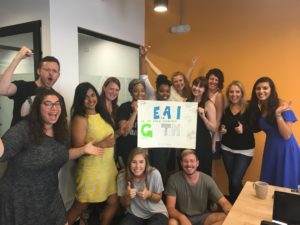
- Poster Board. Preferably with slightly rude signs written on it that indicate how your group of co-travelers are superior to all other groups of travelers.
Pro-Tip—Try to actually color in all of the letters, or your sign will not turn out well in photos.
- 3-4 Person Tent. You never know when you’ll suddenly be bitten by the urge to go camping, even though it’s been about 10-15 years since the last time you went, and you’ve forgotten how to make a fire, and all your food will be stolen by stray dogs before you can eat it anyway. Plus they’re cheaper to buy than rent, so YOLO.
- Yoga Mats. Approximately 10 per person.
- Inflatable Llama. Again, this will make for some priceless Instagramming. But be sure not to leave your inflatable llama lying around—these have been stolen with more frequency than phones this year! Cuidado.
- Hip Flask. A water bottle can work in a pinch, but you’re better off with the real deal. The larger the better, as long as it still fits in your purse. Speaking of which, another one to not forget:
- Purse Tacos and Pocket Burritos. Because you never know when you’ll need a snack.
- Hammock. Because who doesn’t bring these on every trip they take? Honestly. There are trees you can rope these to everywhere, people.
- Poncho. Not the rain-proof kind. I mean the alpaca-wool knit ki
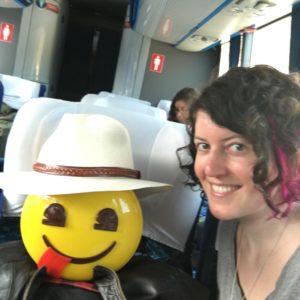 nd. Not only does it work as a jacket, but in case you go camping and accidentally wind up with a Colombian-human-size sleeping bag instead of a normal-human-size one, it doubles as an extra blanket! nd. Not only does it work as a jacket, but in case you go camping and accidentally wind up with a Colombian-human-size sleeping bag instead of a normal-human-size one, it doubles as an extra blanket!
- Bicycle. I know this sounds like a lot of work to disassemble and pack into a box every month to transport, and it is.
- Lunch Box. I recommend buying one that looks like a creepy version of an emoji, so that it doubles as a dummy in case you need to build yourself a pretend friend at any point, or indicate that a particular bus seat is already occupied.
Part II: What To Leave Behind
(Suitcases can only hold so much! When push comes to shove, you’ll need to decide what things you need to leave at home. Some of these are things I previously considered impossible to live without, but take it from me: you do not need them! Save yourself the hassle, and in a few months, you’ll be glad you aren’t lugging these around.)
- Dignity. Look, I know that it sounds nice. But when push comes to shove, nobody really needs this. Even if you do insist on bringing it, you’ll wind up losing it within a couple of months anyway. Personally, I lost mine on day 2 of the Inca Trail, halfway up a mountain with no toilets (not even holes in the ground) in sight. I haven’t missed it once since.
- Standards. Again, this one can sound appealing. High standards are a good thing to maintain, right? Well, not always. Especially when it comes to things like potable tap water and food that doesn’t taste like a dry arepa covered in sugar. Look, you’re traveling around the world. Things are going to be weird and sometimes unpleasant. Lower your standards—or better yet, get rid of them entirely—and the whole experience just gets that much more entertaining.
That, or you just slowly start going mad. One or the other.
- Expectations. Same with standards, really. The more you can avoid having these, the more pleasantly surprised you’ll be by the quirky new apartment you’ve got, where the oven could pass for the final step in a particularly challenging Escape Room game and you’re sleeping in servants’ quarters attached to the kitchen with its own toilet shower (that would be a toilet with a shower directly above it, yes).
Disclaimer: I realize those last couple leave-behinds sound like I might be complaining. I’m honestly not—but only because I left those pesky things behind! You will enjoy this year so much more without them.
Additional Disclaimer: For the sake of transparency, I’ve only included items that people on our trip have actually packed and brought with them to various countries. There are several other Remote Year groups around (though none of them are Meraki #merakiogfy), however, and they may have some good tips as well. For example, apparently one of the new groups, Kaizen, is traveling with a life-size cardboard cutout of Jonathan Lipnicki, a move that has already gotten them a shout-out from the man himself. I do not have any direct feedback on how much this item has benefited them in daily life, but I can only assume that the answer is “immensely.”
So there you have it, kids. You are now ready for a year of life on the road. Make the most of it! And seriously: Don’t take it all so seriously. <3
March 17th, 2017 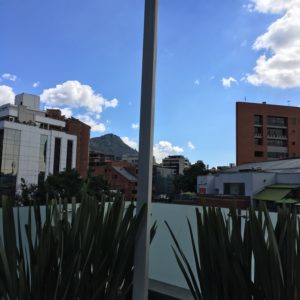 I realize it’s starting to sound like all I do is adventure. That’s about 50% true (okay, maybe 60%). But I’m still working on this trip, and week 4 in Bogotá I really had to buckle down and get some things accomplished (exciting news there, actually—but I will post more about that when I can talk about it publicly!). I realize it’s starting to sound like all I do is adventure. That’s about 50% true (okay, maybe 60%). But I’m still working on this trip, and week 4 in Bogotá I really had to buckle down and get some things accomplished (exciting news there, actually—but I will post more about that when I can talk about it publicly!).
Luckily, we had plenty of good working options throughout the city. Remote Year booked two different Work & Go offices for us, since we were too large a group to fit into a single office here. We had spaces at their larger office up in Chico Norte, a cute neighborhood with lots of cafes and restaurants nearby, as well as a smaller office located right in Zona T, the heart of the bar-hopping and shopping district of northern Bogotá. The smaller one also featured an amazing rooftop view, as an added bonus.
But pretty often, we moved beyond our work spaces this month, discovering more than a few adorable cafes with delicious food and workable Wi-Fi connections.
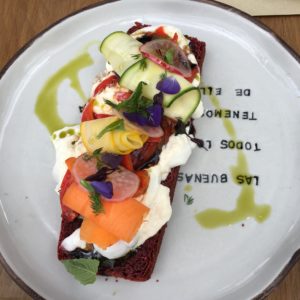 Canasto Picnic Bistro was my personal favorite, a charming white-awning-ed restaurant just off of Park Virrey, which definitely lived up to its name in its picnic-esque vibes. After missing New York’s plethora of brunch options, it was refreshing to be able to hole up at Canasto and devour their variety of quinoa/egg dishes while getting some real writing done. (Their bruschetta was also to-die-for level delicious.) Not to mention, this was the first place in South America where I was served real tea—whole leaf green tea! With a sieve and enough hot water for multiple brews! Canasto Picnic Bistro was my personal favorite, a charming white-awning-ed restaurant just off of Park Virrey, which definitely lived up to its name in its picnic-esque vibes. After missing New York’s plethora of brunch options, it was refreshing to be able to hole up at Canasto and devour their variety of quinoa/egg dishes while getting some real writing done. (Their bruschetta was also to-die-for level delicious.) Not to mention, this was the first place in South America where I was served real tea—whole leaf green tea! With a sieve and enough hot water for multiple brews!
Masa, a bit further south in Zona T, also proved to be a great workspace. The service left a little something to be desired (no matter what you ordered, there was always at least one thing wrong with the dish—though it tasted delicious all the same, so I can’t complain too much), but the atmosphere and tasty fresh salads couldn’t be beat.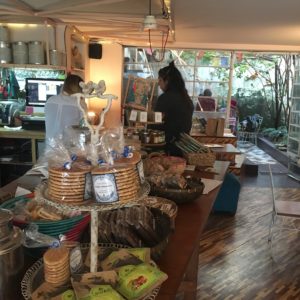
Another exciting find, for me at least, was Taller de Té. This one was a bit farther afield—I had to take an Uber about 30 minutes south to reach it, down near Chapinero. But it was definitely worth the trip. If I’d been excited by Canasto’s tea offerings, just imagine how much more thrilled I was to find a whole selection of teas, from oolongs to green and white varietals, some mixed with fruits or herbs (sorry Shunan), and others just pure tea.
My last week in Bogotá wasn’t all business—we made some time one night to play an escape room at Trap in Palermo. We escaped with time to spare, though not without having to call for a clue, alas. Still, I had a lot of fun solving puzzles with my new friends!
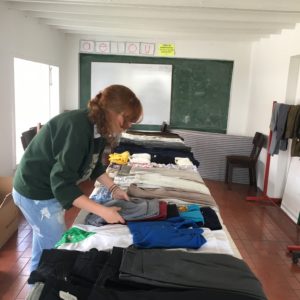 I also volunteered at Fundación Jeymar, an elderly care center, one day that week. Our group makes an effort to organize volunteer efforts in each city we visit, something I appreciate (though of course, when you are traveling and volunteering, you have to be very careful to avoid just falling into the “poverty tourism” trap—winding up in situations where you aren’t helping and may even be doing more harm than good to the local economy). I also volunteered at Fundación Jeymar, an elderly care center, one day that week. Our group makes an effort to organize volunteer efforts in each city we visit, something I appreciate (though of course, when you are traveling and volunteering, you have to be very careful to avoid just falling into the “poverty tourism” trap—winding up in situations where you aren’t helping and may even be doing more harm than good to the local economy).
This particular volunteer day really did feel like a good choice. We went early to set up a “store” created from clothing, home goods and hygiene supplies that had been donated to the care center—laying out the items in a coherent, easy-to-browse way that meant people wouldn’t need to dig through garbage bags or heaped bins of donated items to find what they needed.
But the best part came when we got to interact with the elderly folks who attended the day center. We brought birthday cakes to help them celebrate the February  birthdays, sang Happy Birthday in Spanish together (and taught them the English version), played tejo (the old people kicked my ass), a local ring-toss game, and a backyard version of bowling. birthdays, sang Happy Birthday in Spanish together (and taught them the English version), played tejo (the old people kicked my ass), a local ring-toss game, and a backyard version of bowling.
None of them seemed to mind that only half of us spoke Spanish, and that brokenly. I had a great conversation with one woman, who told me all about her four daughters (and her ex-husband, who left her because he wanted a son, remarried, and wound up with three more daughters—we agreed she was better off without him now).
Another woman gave me plenty of unsolicited dating advice (“Get married and have babies already,” she said, which was only mildly terrifying, though at least she followed it up with a caveat: “But make sure you marry someone at your level. Otherwise you’ll either feel left behind, or like you’re dragging him through life all the time.”).
Not to mention, most of the women enjoyed shouting flirty remarks at the few guys in our volunteer group…
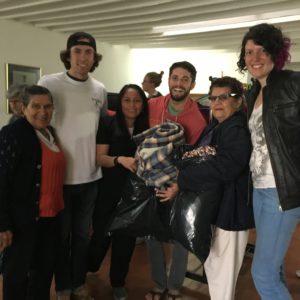 It felt like a fitting end to our month in Bogotá—a way to get to know another generation of locals. Everyone we met there was proud of their country, their city, and the advances that both have made in recent years. It felt like a fitting end to our month in Bogotá—a way to get to know another generation of locals. Everyone we met there was proud of their country, their city, and the advances that both have made in recent years.
By the end of the week, though, as much as I enjoyed my time in Bogotá, I was ready to move on to Medellin and start exploring another facet of this fascinating, surprising country.
I didn’t know much about Colombia coming into this trip, but somehow it finds a way to surprise me every day with the diversity of experiences, cities, nature and ways of life here.
On to the next stop!
 Real tea at Canasto! 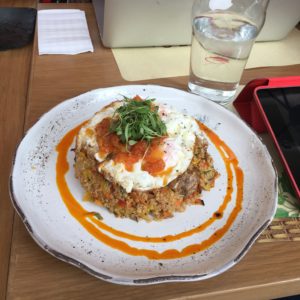 Working lunch with quinoa 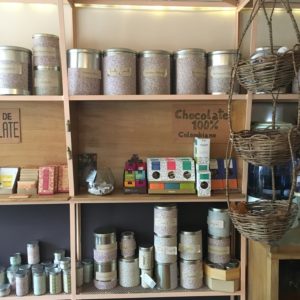 Chocolate and tea selection at Taller de Té  Also, Taller de Té was just adorbs in general
March 16th, 2017 One of the best things about traveling with a huge group of experienced tr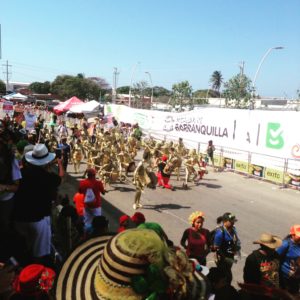 avelers is that there’s always someone planning the next side-trip. I’d gone on a few so far—camping in Neusa and visiting Havana. So when a few people started to talk about visiting carnival in Barranquilla (the second-largest carnival in South America after Rio’s), I jumped on board. I’d never done Mardi Gras (despite being in New Orleans for work the week just before and the week just after it, two years in a row). It seemed like one of those things you need to try at some point in your life, which is what this year is all about for me. avelers is that there’s always someone planning the next side-trip. I’d gone on a few so far—camping in Neusa and visiting Havana. So when a few people started to talk about visiting carnival in Barranquilla (the second-largest carnival in South America after Rio’s), I jumped on board. I’d never done Mardi Gras (despite being in New Orleans for work the week just before and the week just after it, two years in a row). It seemed like one of those things you need to try at some point in your life, which is what this year is all about for me.
In actual practice, however, I could have given the carnival itself a miss.
Don’t get me wrong, I enjoyed partying with the great crew of people who went. And a couple of other Remote Year groups wound up there as well, so it was interesting to meet members of those other Remote “tribes” and hear about their experiences this year. Their two groups were on months 7 and 9 respectively, so they had plenty of advice to offer us newbies just finishing up our second month.
But the parade itself was a slow, staggered affair. The stands were a mob scene, a press of humans that would rival Times Square at midnight on New Years’ Eve. Passersby felt free to throw flour in our faces and spray foam into our eyes, our hair, everywhere. Several of our friends had their phones stolen that way, slipped from their pockets while they were doubled over trying to wipe soap from their eyes. Personally, I was lucky that the guy who shoved a fistful of flour into my eyeball (literally, his finger went in my eye) didn’t have any malicious intent (unless you count flour-eye attacks as malicious, I guess). Because I was definitely doubled over pouring bottled water over my contact lens for long enough that someone could’ve nicked my phone, my wallet, half my possessions…
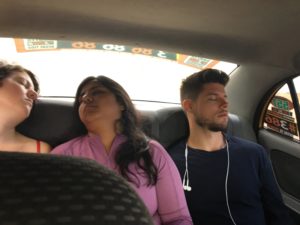 Catching some much-needed rest en route to the dive… I’m glad to have experienced it, but by one in the morning on Saturday night, I was feeling ready to go.
That’s where having those crazy planner friends comes in handy yet again.
One of my friends booked a diving excursion for a few of us certified scuba divers on the trip. When she initially planned it for Sunday morning, leaving at 6am the day after the biggest party in South America, I thought she was crazy.
When I actually rolled out of bed at 5:30am, having lain away since 1am listening to the pounding bass of a street party just outside our building all night, I changed my mind.
Well, okay, not immediately. But the moment our cab rolled up to the beach in Taganga, two hours north of Barranquilla, I knew she had made the right decision. Th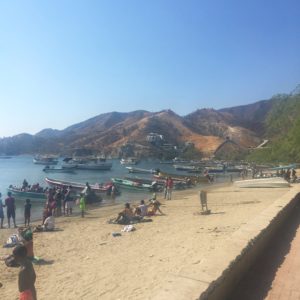 e beach itself looked like a scene straight off the Amalfi Coast—turquoise water, white sand, green mountains surrounding it. e beach itself looked like a scene straight off the Amalfi Coast—turquoise water, white sand, green mountains surrounding it.
At the dive shop, we met the British guy training for his Dive Master who would escort us. We also met Guillermo, a 70-something year old Colombian man who started diving in the Long Island Sound in the 1960s with a tank he bought for $12 at a pawn shop in New York City. Needless to say, he had some great stories about diving along the docks there, earning extra money cleaning barnacles off of oil tankers and skiffs in the Sound.
The dive itself was the best I’ve ever been on (though granted, I only have a handful of dives off the Florida Keys and a couple in the rock quarries of Pennsylvania to compare it to).
 We started by circling a reef in the center of the bay, near Santa Marta. Thanks to my dad the marine biologist’s training early in life, I recognized a lot of the fish we saw—parrot fish, red snappers, butterflyfish, tons of tangs and damselfish, even an eel and a couple of leopard sharks. Me and an enormous angelfish had a fun moment, swimming alongside each other, her completely unbothered by my presence while she nommed some algae along the reef. We started by circling a reef in the center of the bay, near Santa Marta. Thanks to my dad the marine biologist’s training early in life, I recognized a lot of the fish we saw—parrot fish, red snappers, butterflyfish, tons of tangs and damselfish, even an eel and a couple of leopard sharks. Me and an enormous angelfish had a fun moment, swimming alongside each other, her completely unbothered by my presence while she nommed some algae along the reef.
But the real treat was the second dive.
After a quick lunch on a beach nearby, whipped up by our intrepid dive masters, we loaded ourselves back into the motorboat to head to our second destination. I didn’t know until we were about to drop anchor and the dive masters casually mentioned: oh, this one is a wreck dive.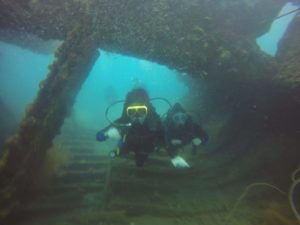
Wreck diving has been on my bucket list since I first earned my certification at age 17. Needless to say, I was pretty hyped to finally get to explore a shipwreck underwater.
I wasn’t disappointed. Visibility wasn’t the best, but even so, you could see enough detail through the silty water to make out the brightly colored coral and varied species of algae that made their home on the wreck, a fishing boat cracked neatly in half, its hull making an easy scoop to swim through. I could have spent all day circling that wreck, poking my head into little side caverns and watching baby blowfish and sand gobies go about their business on its surfaces.
When 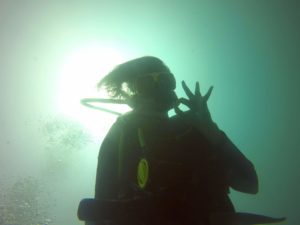 we made it back to shore, divested ourselves of our dive gear, and settled down for a fresh-caught fish dinner and some beers in a tiny wooden hut on the beach, we all agreed: early-morning wakeup and hangovers be damned. We made the right choice coming up there to dive. we made it back to shore, divested ourselves of our dive gear, and settled down for a fresh-caught fish dinner and some beers in a tiny wooden hut on the beach, we all agreed: early-morning wakeup and hangovers be damned. We made the right choice coming up there to dive.
I might have given Barranquilla a miss, but diving Taganga made it all worth it. Definitely my best side trip in Remote Year so far—and if you ever do head up that way, Oceano Dive Shop did a fantastic job.
Plus, it only cost $66 for a two-tank dive, including all of our rental gear. Probably the cheapest dive I’ve ever done!
Though it definitely won’t be my last one this year, so stay tuned…
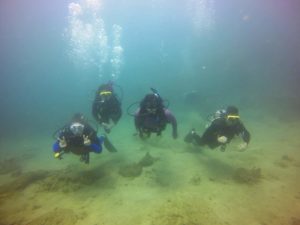 Meraki Dive Crew! (That’s me second from the left) 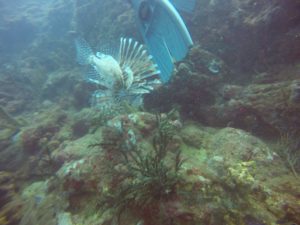 Oh, and we also saw a TON of lionfish… 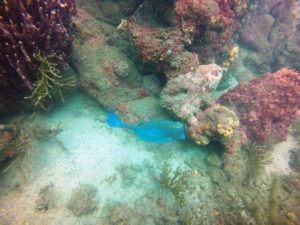 Also saw this mystery fish… Boxfish of some kind? Tang? IDK! 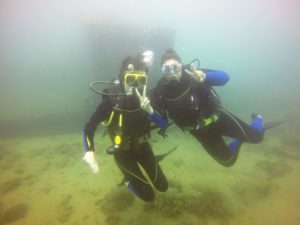 Me and my dive buddy! 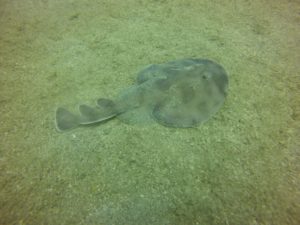 I see you hiding there… 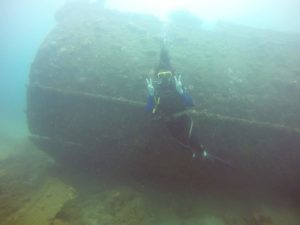 Peacing out next to the other half of this wreck!  Sunset on the beach after our dive…
March 14th, 2017 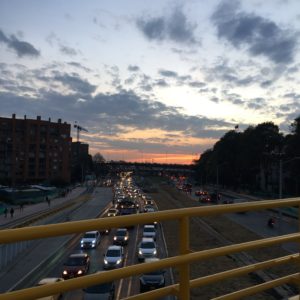 My first month on this adventure was a whirlwind. Trips, tours, parties, excursions every day (and most nights, too). Month two was where the need for normalcy started to set in. The desire for at least some semblance of a routine, even if it’s a routine that will change frequently. My first month on this adventure was a whirlwind. Trips, tours, parties, excursions every day (and most nights, too). Month two was where the need for normalcy started to set in. The desire for at least some semblance of a routine, even if it’s a routine that will change frequently.
It probably helped that, due to scheduling, we were in Bogotá a little longer than Mexico City. Long enough to feel settled, albeit temporarily.
By week 3, I didn’t feel pressure to run around the city trying to experience absolutely every inch of the place. Some of my friends were off doing cool things, and some of them were working their butts off, and some of them were taking it easy at home. If Mexico made me feel like I had to be on 24/7, constantly in the middle of the action, Bogotá had the opposite effect.
Instead of going out on the town bar-hopping or clubbing or just trying t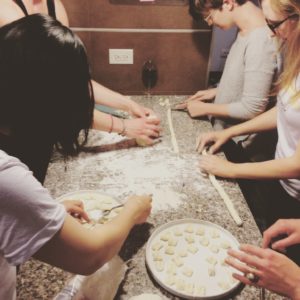 o keep up with the hectic pace of life, one night I went to my friend’s rooftop for a pizza party. Another, a group of us had a girls’ night and saw 50 Shades Darker (yes, it’s as awful as you’d expect—but somehow enjoyable with enough smuggled tequila and a theater full of Colombians also laughing at the terrible dialogue). o keep up with the hectic pace of life, one night I went to my friend’s rooftop for a pizza party. Another, a group of us had a girls’ night and saw 50 Shades Darker (yes, it’s as awful as you’d expect—but somehow enjoyable with enough smuggled tequila and a theater full of Colombians also laughing at the terrible dialogue).
One Friday, a huge group of us ventured over to a friend’s house for a homemade Italian dinner, cooking tons of different pasta dishes, fish, and gnocchi. The gnocchi turned out to be tricky without a food processor, but we had tons of fun tasting all the dishes, singing along to 90s music and just enjoying the company of the other travelers on this adventure with us.
Later in the week, I had a friend over to watch TV—but we failed to make the TV work, and wound up playing Rummy 500 with a deck of cards we smuggled into a bar instead. The next night, we had more friends over (some of whom had actual technological skills) and managed to work the TV for a sci-fi night (re-watching favorite episodes from Firefly and Next Gen, obviously).
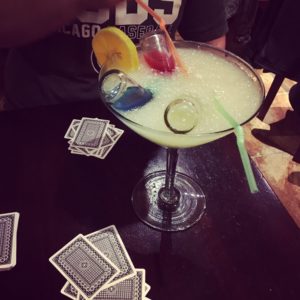 Another night, we watched Devil Wears Prada with some people who had never seen it before, then started Narcos. It was a little trippy, but a lot more powerful, to watch the scenes play out in neighborhoods of the city that we’d already explored. Neighborhoods that until relatively recently still looked like that show. I’m still only part of the way through season 1, but I need to binge it at some point and catch up, if only to better understand one aspect of the history of the country we’ve been living in. Another night, we watched Devil Wears Prada with some people who had never seen it before, then started Narcos. It was a little trippy, but a lot more powerful, to watch the scenes play out in neighborhoods of the city that we’d already explored. Neighborhoods that until relatively recently still looked like that show. I’m still only part of the way through season 1, but I need to binge it at some point and catch up, if only to better understand one aspect of the history of the country we’ve been living in.
At some point, the altitude hit me—Bogotá is ~8,600 feet above sea level, the highest place I’ve ever lived. Mexico City, at only 7,300 feet, didn’t bother me. But I felt it here. Even just walking down the street to work made me feel as though I’d just run a mile. At night especially, I struggled to take deep, even breaths—which made it pretty difficult to fall asleep. Suddenly I understood why in medieval times, people talked about the “hag on the chest” sensation. Some nights it really did feel as though someone were sitting on my chest, weighing me down.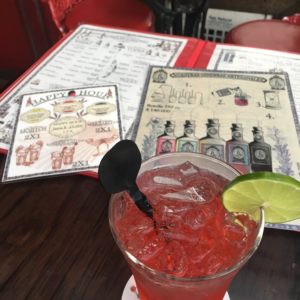
Coca tea saved my ass. I tried over-the-counter and prescription medications for altitude sickness, none of which seemed to make a noticeable difference. But the moment I finished drinking a cup of coca tea in La Candelaria, my lungs seemed to expand to twice their size, oxygen flooding my brain. Maybe it was psychosomatic, but either way, I’ll take it. Slowing down in this city probably also helped my recovery a bit, too.
All in all, Bogotá was a good follow-up from Mexico City. A break from the hectic pace of Remote Year thus far, and a return to “normal” life—if you can call our nomadic lifestyle normal. For this month, at least, it felt that way.
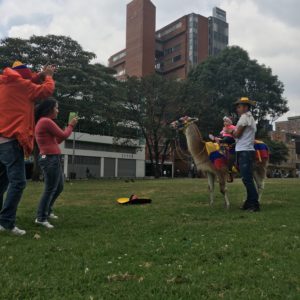 But even on chill weeks, we still have some fun. Just like this baby on a llama in a park.  And ordering a basket full of bread and cake for breakfast 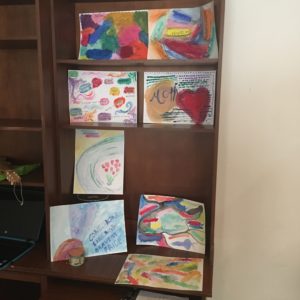 Also, we did some art therapy with my Bogotá roommate’s mom!
March 7th, 2017 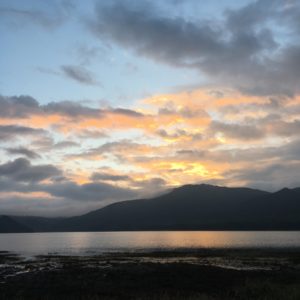 I don’t have a lot of practical survival-in-the-wilderness skills, a fact that was never more obvious than on the weekend side-trip a few of us took from Bogotá up to Embalse del Neusa, a beautiful state park nearby. I don’t have a lot of practical survival-in-the-wilderness skills, a fact that was never more obvious than on the weekend side-trip a few of us took from Bogotá up to Embalse del Neusa, a beautiful state park nearby.
One of the other Remotes on our trip is actually from Colombia, and she’d been camping here a number of times, so she planned the excursion. It was a great idea—Neusa is beautiful, and a weekend away from the hustle of city life sounded amazing.
After stopping for groceries in Zipaquirá, we squished 12 people (plus all of our camping gear, food, and wood) into a van built for 9, and ventured up into the park. Thanks to a combination of a late start, our grocery run, and a bit of confusion at the park entrance about where we could buy wristbands for camping permits, we didn’t arrive until after sunset. That meant pitching tents in the dark—but luckily, a few of my fellow travelers came prepared with headlamps and lanterns, so we did a pretty good job of it.
Our first meal, likewise, went well. Mostly thanks again to my fellow 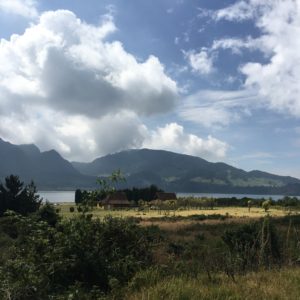 Remotes—between their food-pairing skills and cooking-on-campfire-coals experience, we wound up with delicious fish filets on veggie beds for dinner, with a side of rice that turned out surprisingly well considering it was boiled on an open fire. Remotes—between their food-pairing skills and cooking-on-campfire-coals experience, we wound up with delicious fish filets on veggie beds for dinner, with a side of rice that turned out surprisingly well considering it was boiled on an open fire.
Unfortunately, that was the end of our well-planned meals, since while we were all enjoying that dinner, packs of stray dogs ate most of the other food we brought… We managed to salvage a package of hot dogs and some eggs, but that was about it.
Still, we enjoyed ourselves passing rum around the campfire and joking late into the (increasingly chilly) night.
The next morning, we woke up (grumbling) in time to watch the sunrise over the lake next to our campsite. Even with the clouds and mountains between us and the sun, it was a fantastic view.
After that, our morning got a bit more chaotic. It all started with the firewood. We didn’t have much to start with, and what we did have was damp from a late-night rainstorm. Combine that with some equally damp firestarters and tricky lighters, and let’s just say it took a while to get a breakfast fire going.
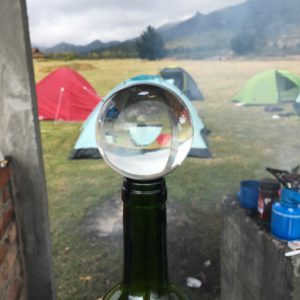 Once we had one roaring, we made do with our remaining food—hot dogs and eggs for everyone! Unfortunately, we didn’t realize until after we’d already cooked and eaten most of the hot dogs that they were still tightly seran-wrapped in plastic… So much for a healthy breakfast? Once we had one roaring, we made do with our remaining food—hot dogs and eggs for everyone! Unfortunately, we didn’t realize until after we’d already cooked and eaten most of the hot dogs that they were still tightly seran-wrapped in plastic… So much for a healthy breakfast?
To be honest, though, burnt-plastic covered hot dogs still taste exactly like regular hot dogs. Which was in and of itself a bit concerning…
Fortunately, when half of us campers left for a long morning hike, we discovered that there was actually a restaurant right next to the entrance of the campsite (a restaurant that sells firewood, no less!). We were saved by the home-grilled arepas and the fresh-caught trucha (straight from the lake on which we were camping).
All in all, it was a great weekend, despite the rain, the cold, the dogs stealing all of our food, and the accidental ingestion of burnt plastic. This trip was the first time I really came to appreciate the diversity of experiences and life skills we all bring to this adventure—whatever we needed to figure out, whether it was fire-building or cooking or just the logistics of renting out a campsite, we had people who stepped up to the plate. Plus it’s good to know that our group can still have fun (and a lot of laughs) even when the elements are against us.
But I’m definitely going to brush up on my fire-building and tent-pitching skills before I venture into the Colombian wilderness again…
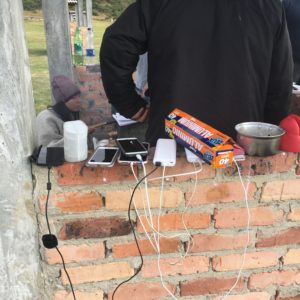 We were totally disconnected for the weekend, we swear…  Cows spotted on our morning hike  The van on the way home – now imagine this same size van with 5 more people and 100% more groceries packed into it…  Our adopted camp dog. Yeah, she probably ate all of our food in the middle of the night. But look at those puppy-dog eyes…
March 6th, 2017 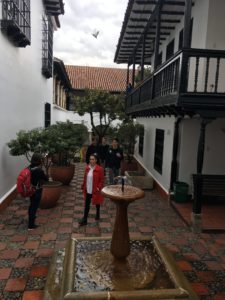 I didn’t want to make the same mistake in Bogotá that I did in Mexico City—namely, waiting until my last week to try to cram in all the local tours. So I signed up for the free walking tour of the historic district, La Candelaria, the very first week I was here. I didn’t want to make the same mistake in Bogotá that I did in Mexico City—namely, waiting until my last week to try to cram in all the local tours. So I signed up for the free walking tour of the historic district, La Candelaria, the very first week I was here.
The walking tour covered both older and more recent Colombian history, including a few basics about the emerald trade, the FARC war, the Colombian revolution (which led to Colombia’s independence from Spain), and even the local beer wars that started back in the early 1900s and are still brewing (haha, sorry…) today.
But the tour wasn’t all talk—we sampled a local beverage called chucula. Chucula was developed when the price of cocoa began to skyrocket in the region. It’s basically a chocolate replacement, a mix of various spices and just a couple of cacao beans, rolled into tight-packed balls that you can dissolve into hot cups of water or milk to create a hot chocolate-esque beverage. I liked it even more than hot chocolate, because it still had a hint of chocolate-y flavor without being overwhelmingly sweet or rich. But that could just be my taste buds!
After the chucula, we also tried chicha, a traditional corn beer that tastes (to me, anyway) like a cross between sour beer and cider. I enjoyed it, though I think it would be hard to drink more than a pint of it, since it’s pretty sour.
Chicha used to be crazy popular in Bogotá until the Bavarians rolled into town and started an ad campaign to demonize the drinking of chicha. All so they could run it out of business and fill the resulting gap with their own beer, naturally!
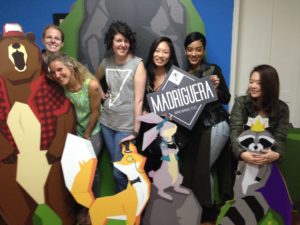 That was my first introduction to the beer wars here, but it wouldn’t be the last. Later in the week, I went on the Bogotá Craft Beer Tour, which took us from a small microbrewery in La Candelaria out through the other neighborhoods, stopping at a tiny brewery called Madriguera located in what looked like someone’s renovated house, another bar built by a brother-and-sister brewer-and-architect duo, and to eat and drink at a delicious local restaurant, Cervecería Gigante. That was my first introduction to the beer wars here, but it wouldn’t be the last. Later in the week, I went on the Bogotá Craft Beer Tour, which took us from a small microbrewery in La Candelaria out through the other neighborhoods, stopping at a tiny brewery called Madriguera located in what looked like someone’s renovated house, another bar built by a brother-and-sister brewer-and-architect duo, and to eat and drink at a delicious local restaurant, Cervecería Gigante.
Along the way, our guide talked about the pushback these local microbrewers have encountered as they get started here in Bogotá. It’s difficult to break into a market dominated by Bavaria, a Colombian beer company owned by Anheuser-Busch. 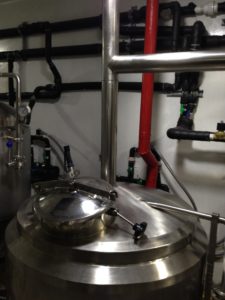 Local, small-batch brewers are still fighting same battles that chicha ran into over a century ago—being stigmatized and out-campaigned in a tough market. But there’s a growing resistance to bigger beer companies here, and a push toward drinking locally made microbrews, which will hopefully only continue to grow in the future. Local, small-batch brewers are still fighting same battles that chicha ran into over a century ago—being stigmatized and out-campaigned in a tough market. But there’s a growing resistance to bigger beer companies here, and a push toward drinking locally made microbrews, which will hopefully only continue to grow in the future.
On another downtown walking tour through La Candelaria, I learned more about the other battles that have been fought (and are still being fought) on Colombian turf. Bogotá has some of the most beautiful and varied street art I’ve ever seen, and the graffiti tour walks you past some of the best examples of work in different styles. But the guides also talk a lot about the politics of street art here—the violence and wars the art depicts and protests, as well as the current move by the government to promote street art (and in doing so, cut down on unauthorized graffiti tagging).
It was a fascinating tour, all in all, but it didn’t even come close to walking us past all the art La Candelaria and the surrounding neighborhoods have to offer. There’s now even a panel of art in Palermo created by some other members of my Remote Year group (Meraki pride, woo!).
Venturing a little ways outside of Bogotá itself, I visited the two salt mines nearby: Nemocón and the better-known Salt Cathedral of Zipaquirá. If you want my advice, I’d say first of all, don’t visit both—that was a pretty repetitive exercise!
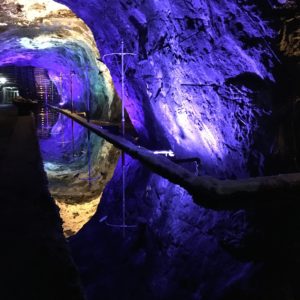 Personally, I preferred Nemocón. It’s a bit smaller, and you can still find the actual salt in the mines. Not to mention carvings made in said salt, a lickable wall, natural deposits that people imagine depict nativity scenes or trees, a massive salt pond mirror that’s so convincingly reflective that standing next to it feels like you’re about to plunge off a ledge, and of course, Salt Jesus. Personally, I preferred Nemocón. It’s a bit smaller, and you can still find the actual salt in the mines. Not to mention carvings made in said salt, a lickable wall, natural deposits that people imagine depict nativity scenes or trees, a massive salt pond mirror that’s so convincingly reflective that standing next to it feels like you’re about to plunge off a ledge, and of course, Salt Jesus.
Fun fact, Nemocón was also the location where The 33 (that movie about the trapped Chilean miners) was filmed. You can explore the set and imagine just how claustrophobic it must have felt to be those guys.
Zipaquirá, on the other hand, was much larger, but also way more touristy. The Salt Cathedral itself is lovely, but left me wondering where all the salt was (the sculptures inside are either carved from rock or marble). Plus, the mall tacked onto the outside is just strange. Unless you’re shopping for some tourist emeralds, then I guess it’s a good stop 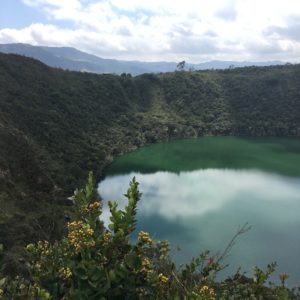 to make. to make.
The last tour I did, which I actually went on a couple weeks later, but I’ll include it here for good measure, was to Lake Guatavita. Best known as the origin of the myth of El Dorado, our local guide explained Guatavita as the Muisca’s version of the Aztec temples. The Muisca people worshipped the moon here, so it made sense that rather than building grand temples to try and reach the sky, they would make a sacred space of a deep, nearly perfectly circular lagoon instead.
Many sacred lakes dot the hillsides in this region, but Guatavita is the largest and best-known. It was here that future tribal rulers were crowned—though not until they had undergone extensive trials to judge their worth, including living for 9 years in total darkness within a cave (a year for every month their mothers carried them to symbolize their gestation and rebirth) and exiting naked to a ritual where nude women danced around them, trying to seduce them. If they reacted at all (yes, you know what I mean), they were deemed unfit to rule.
But, our guide assured us, every ruler who reached that phase of the trial passed. They were then covered head-to-toe in gold dust, and swam out to the center of Lake Guatavita in the final ceremony.
All in all, there are a plethora of tours both within Bogotá’s city limits and outside it. If you’re ever in the city, I’d recommend deciding what parts of local history call to you, and checking out the tours that cover those topics!
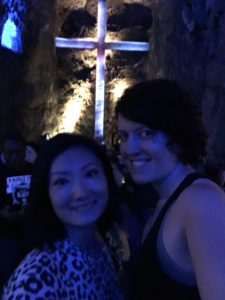 Ellens in the Salt Cathedral  Yes, I licked this wall 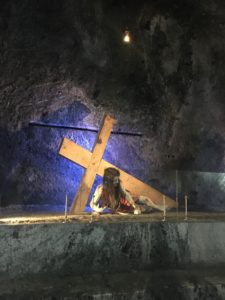 Salt Jesus 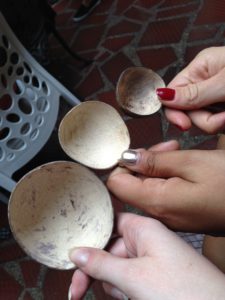 Chicha cups  Street art in Candelaria 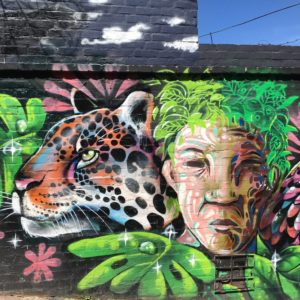 More street art 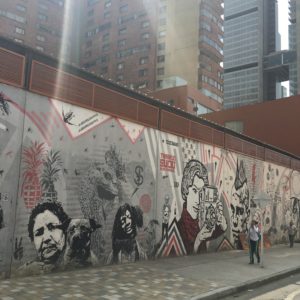 Political commentary via street art 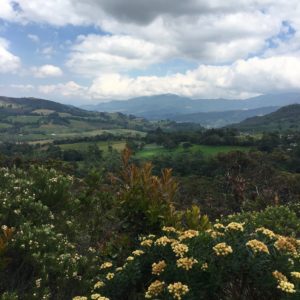 View from the hike up to Guatavita
March 2nd, 2017 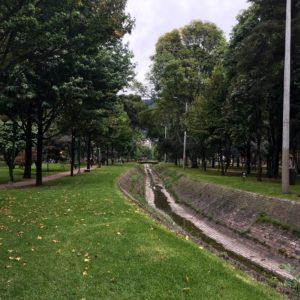 As much as I loved my time in Mexico City, I have to admit that after a month of living there, the pollution was getting noticeable. Every time I left the city, I’d feel my lungs expand and my throat clear (not to mention my sinuses). As much as I loved my time in Mexico City, I have to admit that after a month of living there, the pollution was getting noticeable. Every time I left the city, I’d feel my lungs expand and my throat clear (not to mention my sinuses).
So on my first Sunday in Bogotá, a day when the city bans any non-essential cars from the roads (and closes a lot of those roads for bikers and runners to use), breathing was first and foremost in my mind.
Taking a stroll through Virrey, the scenic park right next to my apartment in Bogotá, and gazing up at the mountains in the not-so-distant distance, I realized that this city was exactly what I needed after a month of eating myself silly in Mexico. (It didn’t hurt that the first thing I wandered across in the park was a mobile bookstore where a few neighborhood kids were stocking up on their next paperback novel, either.)
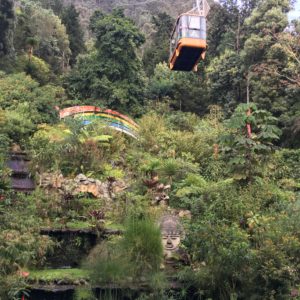 There’s nature everywhere here. That first evening, I took a cable car up to Montserrate (not to be confused with the one near Barcelona), the mountaintop shrine that overlooks the whole city, and drank in the view of Bogotá at dusk. It’s a sprawling metropolis, boasting only ~400,000 less people than New York City (albeit in over twice the space). Yet everywhere you look, you can find green—tree-lined avenues planted on the busiest streets to absorb the bus fumes, parks carved out in each neighborhood, and of course, the mountains that border it all. There’s nature everywhere here. That first evening, I took a cable car up to Montserrate (not to be confused with the one near Barcelona), the mountaintop shrine that overlooks the whole city, and drank in the view of Bogotá at dusk. It’s a sprawling metropolis, boasting only ~400,000 less people than New York City (albeit in over twice the space). Yet everywhere you look, you can find green—tree-lined avenues planted on the busiest streets to absorb the bus fumes, parks carved out in each neighborhood, and of course, the mountains that border it all.
Since then, I’ve found myself waking up earlier than I ever have in my life. Not only did I volunteer for a 6am hike up to Sendero Quebrada La Vieja, a hike straight up a mountain that starts right in downtown Bogotá and is open every morning, but I actually enjoyed it. We lost both our tour guide and our local friend (a theme that became common throughout my time here), and yet we make it to the peak anyway, enjoying an early morning view of the city. Not only that, but since we’d lost our guide and gone a different route, we found a whole new section of the mountain, a dense pine forest carpeted in needles so thick that it felt like hiking over a trampoline (and through an episode of BBC’s Robin Hood).
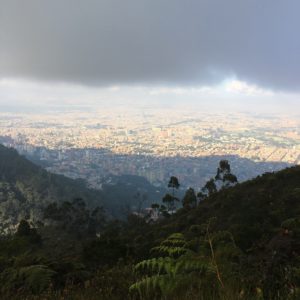 I started waking up early other days, too. Going for early morning runs through the park was a great way to jumpstart my brain for the day of writing ahead. It also, admittedly, turned out to be a pretty good cure for hangovers. I started waking up early other days, too. Going for early morning runs through the park was a great way to jumpstart my brain for the day of writing ahead. It also, admittedly, turned out to be a pretty good cure for hangovers.
Which was needed after we discovered our new favorite bar night: Gringo Tuesdays at La Villa. The idea is, you come to the bar early for happy hour, join a language exchange table (labeled by flags—we sat at the English tables, since a lot of locals and visitors from around South America went to the club night to practice their English), and chat in the assigned language for a few hours. Then around 9pm, the tables are cleared away and the club night begins.
It doesn’t end until 3am, so be prepared for the long haul if you go.
In addition to a new favorite bar, we also found our new favorite game. Only Colombia would think up a backyard game like Tejo, which involves taking a heavy puck-shaped rock and throwing it as hard as you can at a mud-caked target packed with explosives in the center. If you blow up an explosive, you get 3 points. Otherwise, you get 1 point for throwing your tejo closest to center.
It’s mostly a countryside game, but you can find places within the city limits like Club de Tejo la 76, where we played. Unlike bowling, you don’t pay to book a lane—you pay by buying cases of beer to drink during the game. I’m blaming the beer for how I ended up accidentally hitting 3 of my fellow travelers with the tejo rock…
All in all, we had a great first week in Bogotá, and a much-needed slow-down after the hectic pace of life in Mexico City. More on my Bogotá adventures soon, but if you’re impatient, I keep a much more up-to-date record of the goings-on running over on my Instagram page. Give me a shout over there!
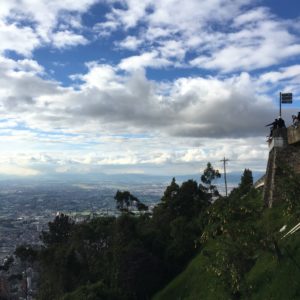 The view from Montserrate 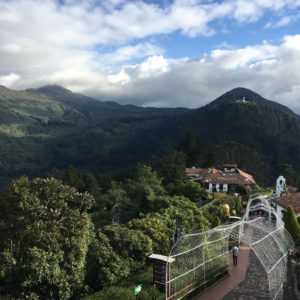 Don’t mind me, I just live in a postcard now  Seriously, what even…  Inspired to write! 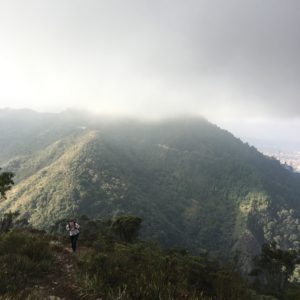 This mountain was steep as hell for a 6am trek… 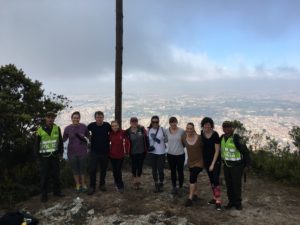 But we made it to the top! And made some policía friends along the way
March 1st, 2017 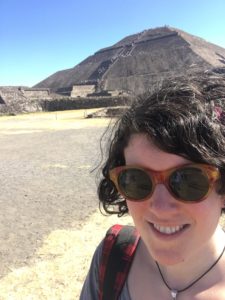 My last week in Mexico City was a whirlwind of preparations. Booking future side-trips, figuring out how many pesos I’d need to get through one last week, stocking up on items I needed to buy for the rest of my trip… And figuring out how to repack my bags in a semi-reasonable manner. My last week in Mexico City was a whirlwind of preparations. Booking future side-trips, figuring out how many pesos I’d need to get through one last week, stocking up on items I needed to buy for the rest of my trip… And figuring out how to repack my bags in a semi-reasonable manner.
But I saved plenty of time for exploring the city, too.
I finally made it to the pyramids in Teotihuacán. The Sun and Moon pyramids are the most famous, but there are actually around a dozen pyramids scattered around the site, with more earthen mounds that have yet to be excavated hiding still more pyramids beneath them.
There, we learned about the mysterious origin of the so-called City of the Gods. Built between 100BC-250AD, it was the largest city in the Americas prior to Colombus’s arrival. Most people associate it with the Aztecs, but actually, by the time they discovered Teotihuacán, it had already been abandoned for centuries. The city fell around 750AD, most likely due to an internal uprising, though the jury is still out on that one.
Recently, archaeologists discovered several new tunnels beneath the site, including a tunnel beneath the Temple of the Feathered Serpent that’s still being excavated. Our guide, a local archaeologist with UNAM, plied the team working on the excavation with tequila, but sadly, they didn’t have anything new to report yet.
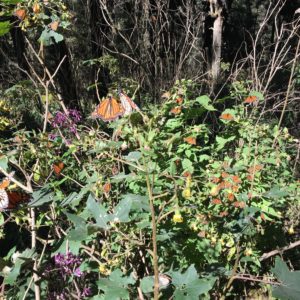 In addition to the pyramids, I trekked out to El Rosario Monarch Butterfly Sanctuary with a couple friends. This is a sanctuary for the monarch butterflies, who fly there from Canada every winter, then fly home every summer. For the moment, in the depths of January, they were in hibernation mode—but they still venture out during sunlight hours to eat/breed/all that good stuff. In addition to the pyramids, I trekked out to El Rosario Monarch Butterfly Sanctuary with a couple friends. This is a sanctuary for the monarch butterflies, who fly there from Canada every winter, then fly home every summer. For the moment, in the depths of January, they were in hibernation mode—but they still venture out during sunlight hours to eat/breed/all that good stuff.
I’d never seen the monarch migration up-close, so it was definitely worth the trip (which involved an Uber, a bus, a taxi we paid to sit and wait for us to return, then a 45-minute hike into the mountains, for which I was not at all dressed properly. By the way, it’s a lot colder in the mountains…).
When we reached the top of the mountain and our guide pointed out the butterflies (in Spanish of course), I thought I had misunderstood him. All we could see in the trees were black clumpy masses, like clusters of dead leaves waiting to fall. Then he explained—the butterflies huddle together for warmth, so tightly packed that only the black edges of their wings are visible.
That is, until the sun hits. Then they wake up and start to fly between the trees, down to the ground… Even landing on us more than a few times.
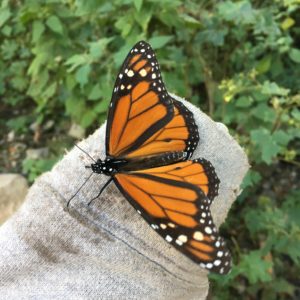 Dude butterfly Luckily for us, we ran into another American woman traveling with her daughter, who had just finished raising some monarchs in her classroom for release. She taught us how to tell the males from females (males have black spots on their hind wings), among other useful tips.
After a carne asada (think Mexico’s version of a backyard cookout) on my Spanish teacher’s rooftop, followed by a day of relaxing at Hotel Habita‘s rooftop pool (pro-tip: even if you aren’t a hotel guest, they only ask that you spend a minimum of $200 pesos/~$10 USD at the poolside bar in order to hang out for the day—easy to do when they have an extensive food menu, not to mention micheladas on hand), I powered through the last few to-dos on my Mexico City list.
That included the free walking tour of the historic district downtown, which I cannot recommend enough. It’s one thing to read about the Aztec’s afterlife beliefs, but quite another to be taken down into the bowels of the city (below the modern street level, since Mexico City is slowly sinking) and led through an artistic representation of that underworld.
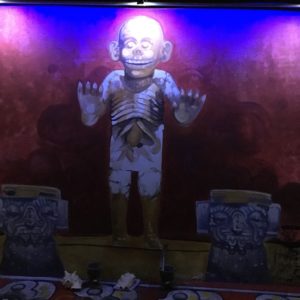 Chillin’ underground with Mictlantecuhtli Plus, once the tour finished, we were in the perfect spot to enjoy a delicious mole and some cocktails at La Casa de las Sirenas, a mezcal bar downtown.
Our last night in Mexico City, we celebrated with a Remote Year-organized boat ride along the canals of Xochimilco, another must-do. There, you can still see the chinampas, vast floating rafts on which the ancient Mesoamericans cultivated farms and built homes. Mexico City used to be built on these rafts as well, until the lake where it originally sat drained. It’s truly a wonder of ancient architecture and ingenuity—and pretty fun to sail between, too.
But after that, it was time to say our (slightly hungover) goodbyes and board our flight to Bogotá. I’ll miss Mexico City, the history, the food, the art, the culture, and did I mention the food. But there will always be time to go back and hit any of the spots I missed. Until then, it’s off to the next city on our list!
 Thousand-year-old street art  Just your casual erosion-exposed tomb beneath the sinking cathedral… 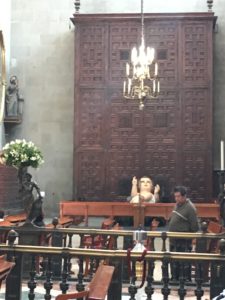 Also your casual giant baby Jesus in said sinking cathedral 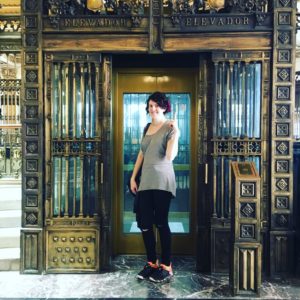 Elevator at the historic post office in downtown CDMX  Street parade protesting gas prices  Boarding our fleet of boats on the Xochimilco canals  Canal selfie!
February 2nd, 2017 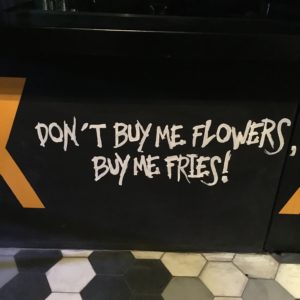 At the end of each month this year, I’m going to tally up my expenses in order to evaluate the costs of living in each city we’re visiting. A month is a good time to get an estimate of how much it would cost to settle down in a city, and for anyone out there working remotely for a U.S. company, a lot of these places are much cheaper to live in than the U.S. itself. At the end of each month this year, I’m going to tally up my expenses in order to evaluate the costs of living in each city we’re visiting. A month is a good time to get an estimate of how much it would cost to settle down in a city, and for anyone out there working remotely for a U.S. company, a lot of these places are much cheaper to live in than the U.S. itself.
Now, some of my estimates will be off, since I’m traveling with a program, and not paying for my own housing or office space rentals. I pay $2,000 USD a month for my office/apartment/some events with the group.
But just for estimates’ sakes, I’ve done some digging, and average apartment rent for the neighborhood we’re staying in (Roma Norte/Condesa, a very trendy Brooklyn-esque ‘hood) seems to range from ~$500-1000 USD for a 1-BR apartment. Office space rentals vary depending on size/location/amenities, but I found a few decent-looking listings in the $300-450 USD range.
So, after a month in Mexico City (the world’s 10th largest metropolitan area as of 2015, with a population of 21.3 million), here’s how the finacials of what I actually spent break down:
Food (in Restaurants): $562.78
Food made up the biggest piece of my spending pie. This was not surprising, since a) I ate out almost every meal, lunch and dinner (see here for more details), and b) living in NYC, I already tended to splurge on dining out pretty often. And when I’m in a new country, especially a new country full of delicious new cuisine to sample, well…
But I should note that one of those meals was at one of the top fine dining restaurants in the world, and it still only cost $160.26 (and made up a big chunk of my dining-out expenses by itself). My average cost-per-meal not counting Pujol was $8.38.
Living Expenses: $166.48
I included groceries in this category, along with the usual necessities like toilet paper, bottled water (the tap water isn’t always potable in Mexico City), laundry and cleaning supplies, etc.
Shopping: $332.42
Again, bit of a splurge category, though I mostly only splurged on practical items. A quick breakdown of the biggest expenses:
$117.40 – new trail-runners and hiking pants for Machu Picchu (not to mention for all the running I need to start doing to work off these tacos)
$194.07 – new leather jacket (half off, no less) because I very, very stupidly left mine at home. Do not do this, kids. Learn from my mistakes.
Medical: $117.92
This looks like a large amount, but keep in mind that $90.93 of that was buying my allergy medication for the next 6 months. At home, that same amount of allergy medicine would have cost me $300 out-of-pocket, AFTER my insurance deductions.
Drinks: $127.38
 Again, not too surprising, considering I’m in a new country with a zillion new beverages to sample (mezcal, anyone?). Again, not too surprising, considering I’m in a new country with a zillion new beverages to sample (mezcal, anyone?).
Transportaion: $117.58
The vast majority of this (except for $21.70 spent on a bus to see the monarch butterfly migration up north) was spent on Ubers alone. But this is with me taking Ubers to and from events nearly 5 nights a week, and that’s also keeping in mind that some of those Uber rides were 1+ hours long.
Museums/Tours/Shows: $29.67
This isn’t technically a living expense, since if I moved to Mexico City, I likely wouldn’t be doing things like going to Lucha Libre shows or visiting the Anthropology Museum not once but twice in a month (listen, the Piedra del Sol is cool as hell, okay?). But it’s part of my spend this month, so for the sake of completeness, I’m including it.
Overall Monthly Spend: $1,454.24
This was a bit of a splurge month for me, though, since it’s my first month on the road, first month meeting all my new traveling companions, first month adjusting to the cooking-at-home versus eating-out balance of a new location.
Taking into account the fact that a) I went out almost every night (often with 79 friends who needed to meet up in places large enough to accomodate huge groups of us), b) I’m being a major tourist, and c) I stocked up on meds and shopping items for the year ahead, this actually stacks up really well against my usual budget.
In New York City, my average spending was $1,800 on rent/bills/medical expenses, and another $1,500-2,000 per month on groceries, living expenses, eating out, and going to events.
That said, I’ll definitely be trying to cook at home more often next month.
Onward to Bogotá!
|
Mailing List Follow along as I write and travel around the world.
|




 . Some have good tips—advice on how to keep your luggage weight low and yet still bring enough clothes that you won’t be wearing the same 4 outfits on rotation for an entire year.
. Some have good tips—advice on how to keep your luggage weight low and yet still bring enough clothes that you won’t be wearing the same 4 outfits on rotation for an entire year. Neon Wig. I did not anticipate the number of costume, fancy dress and themed events I would be attending this year. Luckily, rather than packing the entirety of your dress-up trunk, you can turn pretty much any normal outfit into a festival-ready one by adding one accessory: a crazily-colored wig. Doesn’t really matter what color (although personally I recommend purple—it goes with everything!), only that it must be outrageously neon enough that it can be used as a flag in the event of an emergency where you get separated from your group of friends at a 30,000 person concert.
Neon Wig. I did not anticipate the number of costume, fancy dress and themed events I would be attending this year. Luckily, rather than packing the entirety of your dress-up trunk, you can turn pretty much any normal outfit into a festival-ready one by adding one accessory: a crazily-colored wig. Doesn’t really matter what color (although personally I recommend purple—it goes with everything!), only that it must be outrageously neon enough that it can be used as a flag in the event of an emergency where you get separated from your group of friends at a 30,000 person concert.
 t iron pot the size of one. And trust me, if you pass through Colombia at any point, you’re going to want to make ajiaco soup. Or really any kind of soup. Soup is the best food anyway, and you’ll be making a lot of new friends on your travels. What better way to endear them to you than by feeding them a mountain of stew?
t iron pot the size of one. And trust me, if you pass through Colombia at any point, you’re going to want to make ajiaco soup. Or really any kind of soup. Soup is the best food anyway, and you’ll be making a lot of new friends on your travels. What better way to endear them to you than by feeding them a mountain of stew?
 nd. Not only does it work as a jacket, but in case you go camping and accidentally wind up with a Colombian-human-size sleeping bag instead of a normal-human-size one, it doubles as an extra blanket!
nd. Not only does it work as a jacket, but in case you go camping and accidentally wind up with a Colombian-human-size sleeping bag instead of a normal-human-size one, it doubles as an extra blanket! I realize it’s starting to sound like all I do is adventure. That’s about 50% true (okay, maybe 60%). But I’m still working on this trip, and week 4 in Bogotá I really had to buckle down and get some things accomplished (exciting news there, actually—but I will post more about that when I can talk about it publicly!).
I realize it’s starting to sound like all I do is adventure. That’s about 50% true (okay, maybe 60%). But I’m still working on this trip, and week 4 in Bogotá I really had to buckle down and get some things accomplished (exciting news there, actually—but I will post more about that when I can talk about it publicly!). Canasto Picnic Bistro
Canasto Picnic Bistro
 I also volunteered at Fundación Jeymar, an elderly care center, one day that week. Our group makes an effort to organize volunteer efforts in each city we visit, something I appreciate (though of course, when you are traveling and volunteering, you have to be very careful to avoid just falling into the “poverty tourism” trap—winding up in situations where you aren’t helping and may even be doing more harm than good to the local economy).
I also volunteered at Fundación Jeymar, an elderly care center, one day that week. Our group makes an effort to organize volunteer efforts in each city we visit, something I appreciate (though of course, when you are traveling and volunteering, you have to be very careful to avoid just falling into the “poverty tourism” trap—winding up in situations where you aren’t helping and may even be doing more harm than good to the local economy).  birthdays, sang Happy Birthday in Spanish together (and taught them the English version), played tejo (the old people kicked my ass), a local ring-toss game, and a backyard version of bowling.
birthdays, sang Happy Birthday in Spanish together (and taught them the English version), played tejo (the old people kicked my ass), a local ring-toss game, and a backyard version of bowling. It felt like a fitting end to our month in Bogotá—a way to get to know another generation of locals. Everyone we met there was proud of their country, their city, and the advances that both have made in recent years.
It felt like a fitting end to our month in Bogotá—a way to get to know another generation of locals. Everyone we met there was proud of their country, their city, and the advances that both have made in recent years. 



 avelers is that there’s always someone planning the next side-trip. I’d gone on a few so far—
avelers is that there’s always someone planning the next side-trip. I’d gone on a few so far—
 e beach itself looked like a scene straight off the Amalfi Coast—turquoise water, white sand, green mountains surrounding it.
e beach itself looked like a scene straight off the Amalfi Coast—turquoise water, white sand, green mountains surrounding it. We started by circling a reef in the center of the bay, near Santa Marta. Thanks to my dad the marine biologist’s training early in life, I recognized a lot of the fish we saw—parrot fish, red snappers, butterflyfish, tons of tangs and damselfish, even an eel and a couple of leopard sharks. Me and an enormous angelfish had a fun moment, swimming alongside each other, her completely unbothered by my presence while she nommed some algae along the reef.
We started by circling a reef in the center of the bay, near Santa Marta. Thanks to my dad the marine biologist’s training early in life, I recognized a lot of the fish we saw—parrot fish, red snappers, butterflyfish, tons of tangs and damselfish, even an eel and a couple of leopard sharks. Me and an enormous angelfish had a fun moment, swimming alongside each other, her completely unbothered by my presence while she nommed some algae along the reef.
 we made it back to shore, divested ourselves of our dive gear, and settled down for a fresh-caught fish dinner and some beers in a tiny wooden hut on the beach, we all agreed: early-morning wakeup and hangovers be damned. We made the right choice coming up there to dive.
we made it back to shore, divested ourselves of our dive gear, and settled down for a fresh-caught fish dinner and some beers in a tiny wooden hut on the beach, we all agreed: early-morning wakeup and hangovers be damned. We made the right choice coming up there to dive.






 My first month on this adventure was a whirlwind. Trips, tours, parties, excursions every day (and most nights, too). Month two was where the need for normalcy started to set in. The desire for at least some semblance of a routine, even if it’s a routine that will change frequently.
My first month on this adventure was a whirlwind. Trips, tours, parties, excursions every day (and most nights, too). Month two was where the need for normalcy started to set in. The desire for at least some semblance of a routine, even if it’s a routine that will change frequently. o keep up with the hectic pace of life, one night I went to my friend’s rooftop for a pizza party. Another, a group of us had a girls’ night and saw 50 Shades Darker (yes, it’s as awful as you’d expect—but somehow enjoyable with enough smuggled tequila and a theater full of Colombians also laughing at the terrible dialogue).
o keep up with the hectic pace of life, one night I went to my friend’s rooftop for a pizza party. Another, a group of us had a girls’ night and saw 50 Shades Darker (yes, it’s as awful as you’d expect—but somehow enjoyable with enough smuggled tequila and a theater full of Colombians also laughing at the terrible dialogue). Another night, we watched Devil Wears Prada with some people who had never seen it before, then started Narcos. It was a little trippy, but a lot more powerful, to watch the scenes play out in neighborhoods of the city that we’d already explored. Neighborhoods that until relatively recently still looked like that show. I’m still only part of the way through season 1, but I need to binge it at some point and catch up, if only to better understand one aspect of the history of the country we’ve been living in.
Another night, we watched Devil Wears Prada with some people who had never seen it before, then started Narcos. It was a little trippy, but a lot more powerful, to watch the scenes play out in neighborhoods of the city that we’d already explored. Neighborhoods that until relatively recently still looked like that show. I’m still only part of the way through season 1, but I need to binge it at some point and catch up, if only to better understand one aspect of the history of the country we’ve been living in.



 I don’t have a lot of practical survival-in-the-wilderness skills, a fact that was never more obvious than on the weekend side-trip a few of us took from Bogotá up to
I don’t have a lot of practical survival-in-the-wilderness skills, a fact that was never more obvious than on the weekend side-trip a few of us took from Bogotá up to  Remotes—between their food-pairing skills and cooking-on-campfire-coals experience, we wound up with delicious fish filets on veggie beds for dinner, with a side of rice that turned out surprisingly well considering it was boiled on an open fire.
Remotes—between their food-pairing skills and cooking-on-campfire-coals experience, we wound up with delicious fish filets on veggie beds for dinner, with a side of rice that turned out surprisingly well considering it was boiled on an open fire. Once we had one roaring, we made do with our remaining food—hot dogs and eggs for everyone! Unfortunately, we didn’t realize until after we’d already cooked and eaten most of the hot dogs that they were still tightly seran-wrapped in plastic… So much for a healthy breakfast?
Once we had one roaring, we made do with our remaining food—hot dogs and eggs for everyone! Unfortunately, we didn’t realize until after we’d already cooked and eaten most of the hot dogs that they were still tightly seran-wrapped in plastic… So much for a healthy breakfast?



 I didn’t want to make the same mistake in Bogotá that I did in Mexico City—namely, waiting until my last week to try to cram in all the local tours. So I signed up for the
I didn’t want to make the same mistake in Bogotá that I did in Mexico City—namely, waiting until my last week to try to cram in all the local tours. So I signed up for the  That was my first introduction to the beer wars here, but it wouldn’t be the last. Later in the week, I went on the
That was my first introduction to the beer wars here, but it wouldn’t be the last. Later in the week, I went on the  Local, small-batch brewers are still fighting same battles that chicha ran into over a century ago—being stigmatized and out-campaigned in a tough market. But there’s a growing resistance to bigger beer companies here, and a push toward drinking locally made microbrews, which will hopefully only continue to grow in the future.
Local, small-batch brewers are still fighting same battles that chicha ran into over a century ago—being stigmatized and out-campaigned in a tough market. But there’s a growing resistance to bigger beer companies here, and a push toward drinking locally made microbrews, which will hopefully only continue to grow in the future. Personally, I preferred Nemocón. It’s a bit smaller, and you can still find the actual salt in the mines. Not to mention carvings made in said salt, a lickable wall, natural deposits that people imagine depict nativity scenes or trees, a massive salt pond mirror that’s so convincingly reflective that standing next to it feels like you’re about to plunge off a ledge, and of course, Salt Jesus.
Personally, I preferred Nemocón. It’s a bit smaller, and you can still find the actual salt in the mines. Not to mention carvings made in said salt, a lickable wall, natural deposits that people imagine depict nativity scenes or trees, a massive salt pond mirror that’s so convincingly reflective that standing next to it feels like you’re about to plunge off a ledge, and of course, Salt Jesus. to make.
to make.







 As much as I loved my time in Mexico City, I have to admit that after a month of living there, the pollution was getting noticeable. Every time I left the city, I’d feel my lungs expand and my throat clear (not to mention my sinuses).
As much as I loved my time in Mexico City, I have to admit that after a month of living there, the pollution was getting noticeable. Every time I left the city, I’d feel my lungs expand and my throat clear (not to mention my sinuses). There’s nature everywhere here. That first evening, I took a cable car up to
There’s nature everywhere here. That first evening, I took a cable car up to  I started waking up early other days, too. Going for early morning runs through the park was a great way to jumpstart my brain for the day of writing ahead. It also, admittedly, turned out to be a pretty good cure for hangovers.
I started waking up early other days, too. Going for early morning runs through the park was a great way to jumpstart my brain for the day of writing ahead. It also, admittedly, turned out to be a pretty good cure for hangovers.





 My last week in Mexico City was a whirlwind of preparations. Booking future side-trips, figuring out how many pesos I’d need to get through one last week, stocking up on items I needed to buy for the rest of my trip… And figuring out how to repack my bags in a semi-reasonable manner.
My last week in Mexico City was a whirlwind of preparations. Booking future side-trips, figuring out how many pesos I’d need to get through one last week, stocking up on items I needed to buy for the rest of my trip… And figuring out how to repack my bags in a semi-reasonable manner. In addition to the pyramids, I trekked out to
In addition to the pyramids, I trekked out to 








 At the end of each month this year, I’m going to tally up my expenses in order to evaluate the costs of living in each city we’re visiting. A month is a good time to get an estimate of how much it would cost to settle down in a city, and for anyone out there working remotely for a U.S. company, a lot of these places are much cheaper to live in than the U.S. itself.
At the end of each month this year, I’m going to tally up my expenses in order to evaluate the costs of living in each city we’re visiting. A month is a good time to get an estimate of how much it would cost to settle down in a city, and for anyone out there working remotely for a U.S. company, a lot of these places are much cheaper to live in than the U.S. itself. Again, not too surprising, considering I’m in a new country with a zillion new beverages to sample (mezcal, anyone?).
Again, not too surprising, considering I’m in a new country with a zillion new beverages to sample (mezcal, anyone?).